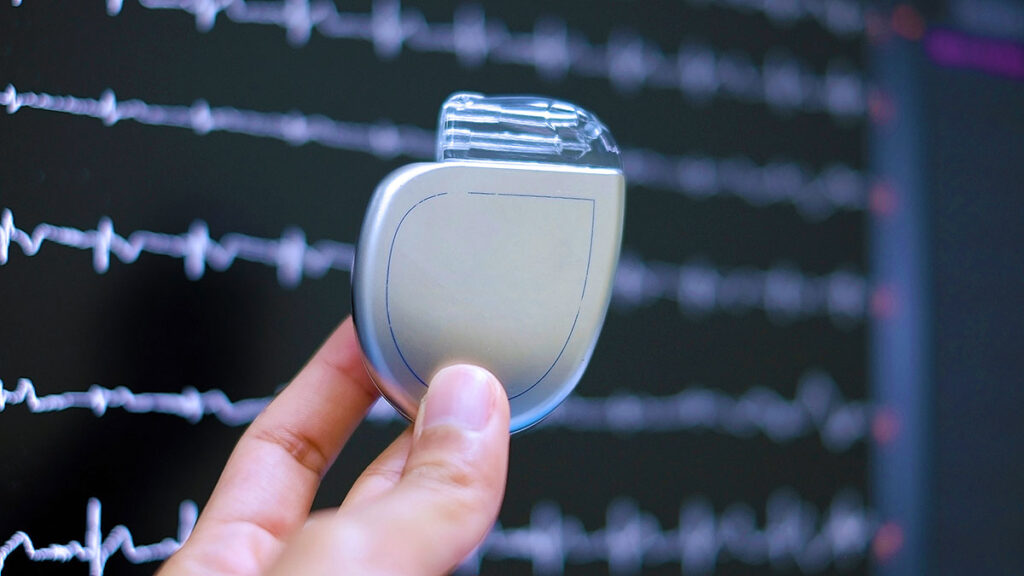For individuals with a history or susceptibility to sudden cardiac arrest, an ICD could be the ultimate solution. Explore the vital role these devices play in delivering life-saving therapy and safeguarding against cardiac emergencies.
What is an ICD?
In the field of Cardiac Rhythm Management (CRM), Implantable Cardioverter Defibrillators (ICDs) stand as a critical defense against the unpredictability of sudden cardiac arrest (SCA), a condition that can strike without warning. Learning more about their significance, function, and impact they have on those at risk is an important first step for potential ICD recipients and their loved ones.
An ICD is a battery-powered device placed under the skin to monitor heart rhythm and deliver electric shocks to conductive cardiac tissue when it detects irregular heartbeats, or arrhythmias. Designed to prevent sudden death from cardiac arrest, ICDs are a testament to the incredible advances in the field of cardiology and electrophysiology.
Key Benefits of ICDs
Understanding the crucial advantages of ICDs can provide insights into their role in patient care:
- Lifesaving Capability: The primary benefit of an ICD lies in its capacity to prevent sudden death by detecting and stopping fatal arrhythmias.
- Heart Rhythm Support: ICDs can also offer crucial support for the heart’s rhythm through the delivery of low-voltage pacing impulses, helping to maintain a stable heartbeat.
- Continuous Monitoring: Offering 24/7 heart rhythm monitoring, ICDs provide patients and their families with continuous reassurance about heart health.
- Tailored Treatment: Reflecting the needs of individual patients, ICDs can be customized in their programming, ensuring the delivery of precise therapy as needed.
The Evolution of ICD Technology
From their inception in the early 1980s to the sophisticated devices we see today, ICDs have undergone significant advancements. Early models were large and required complex surgery for implantation. Modern ICDs are smaller, more efficient, and are implanted using minimally invasive techniques, highlighting the remarkable progress in CRM technology.
How ICDs Work
An ICD continuously monitors the heart’s rhythm. When it detects an abnormally fast or chaotic heartbeat, it attempts to correct it by delivering:
- A pacing pulse: A series of low-voltage electrical impulses to restore or support normal rhythm.
- A cardioversion shock: A synchronized and medium-intensity shock to reset the heart’s rhythm.
- A defibrillation shock: An unsynchronized and high-intensity shock to stop a severely irregular heartbeat. This shock aims to electrically reboot the cardiac conduction system, promoting a return to a normal heart rate.
The Implantation Process
Implanting an ICD is a surgical procedure that usually requires local anesthesia and light sedation. The device is typically placed just below the collarbone, with leads (wires) running from the device to the heart to monitor rhythm and deliver shocks when necessary. Following implantation, a critical wound check ensures proper healing without infection, and the device’s function is assessed to ensure it integrates well with the body.
Recovery and Living with an ICD
Post-implantation, patients can expect a recovery period where activities might be limited. However, most individuals return to their daily routines, with follow-up appointments to ensure the ICD is continuing to function correctly. It’s essential to maintain open communication with a following physician about any concerns or symptoms experienced.
Considerations and Limitations
While ICDs represent a significant leap forward in patient care, they come with considerations:
- Device and Lead Maintenance: Regular check-ups are necessary to ensure the device and leads function properly.
- Lifestyle Adjustments: Patients may need to avoid certain high-intensity activities or electromagnetic fields that could interfere with the device.
- Psychological Impact: The experience of receiving or anticipating a shock can be distressing. Support groups and counseling can help patients cope with their emotions.
Empowering Lives Through Technology
For those at risk of SCA, an ICD could mean the difference between life and death. If you or a loved one could benefit from this lifesaving technology, consider consulting with a cardiologist or electrophysiologist to explore your options. Dr. Adam Budzikowski and his team are dedicated to providing expert care and guidance for patients considering ICD implantation.
ICDs symbolize hope and security for many, offering a shield against the unforeseen threat of sudden cardiac arrest. By understanding and embracing the technology behind ICDs, we can appreciate their role in enhancing patient lives and advancing cardiac care.
CRR
